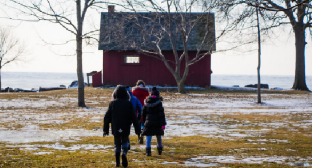OUR REGION
The Essex Region is an 1,841 square kilometre area of land that spans nine municipalities, including the City of Windsor, Township of Pelee Island, and the Towns of Amherstburg, Essex, Kingsville, Lakeshore, LaSalle, Leamington and Tecumseh. It is the southern-most part of the Carolinian Life Zone and contains some of Canada's most significant natural areas. Unlike most other Conservation Authorities, which generally focs on one large watershed, our region includes the watersheds of the Detroit River, Lake St. Clair, and western basin of Lake Erie. It is surrounded by almost 300km of Great Lakes shorelines, the largest freshwater system in the world. The region is blessed with a climate and geography that supports a rich agricultural and industrial tradition that has supported growth in our region. But, there are also significant challenges.
• Our landscape has been intensively developed. In 200 years, we've drained more than 95% of our wetlands, lost almost all of our tall grass prairie and cleared more than 90% of our forests. What's left is disconnected and fragmented. Few parts of Canada have been as extensively developed as Essex Region.
• Our Great Lakes watersheds are impacted by invasive species, nutrients, phosphorous and blue green algae. The water quality of our rivers and streams is degraded, which impacts aquatic wildlife, increases drinking water treatment costs, and negatively impacts recreational use such as swimming and boating.
• Changing and unpredictable climate patterns are causing significant flooding, impacting our shorelines, and creating erosion problems. And the frequency of these types of rainfall events are expected to increase.
• While the Windsor-Essex region is identified a a high growth area, our low lying landscape, flat topography and soils create unique development challenges. Planning for growth and resilient communities and climate change will require different strategies and a more integrated approach.
OUR STRATEGIC DIRECTION
Defined by our mandate under the Conservation Authorities Act (1946), ERCA delivers a number of programs and services to municipalities and residents. Our Strategic Direction is set out in ERCA's 2016-2025 Strategic Plan: Sustaining the Place for Life, which provides the basis for our decision-making and priorities over the decade in five key areas:
- 1. The climate will continue to change. Efforts to slow climate change must continue, but we need to help our partners prepare to adapt to its impacts.
- 2. The Great Lakes are our most significant natural resource. Our 2017 Watershed Report Card identified failing grades for surface water quality in virtually every watershed. More must be done to protect and improve water quality.
- 3. Our habitats are among the most significant in Canada. We have planted more than 6 million trees and achieved 8.5% natural area coverage. But more action is needed to reach our 12% target.
- 4. Our urban areas will continue to grow and expand. ERCA will need to continue to work with all partners to plan sustainable communities that reduce urban sprawl, are walkable, have a healthy food supply and incorporate green infrastructure.
- 5. ERCA is a sustainable, resilient and valued agency. Since 1973, ERCA has been striving to achieve a state of sustainability for the Essex Region. It is also important to consider the sustainability of ERCA as an organization

The Place for Life reinforces that all elements of a place are interconnected – our community, its environmental health, healthy lifestyles for our citizens and our economy. Life recognizes our living, thriving and sustainable natural systems. Life refers to the people of our community – their health and protection and our shared heritage. We embrace this place and make it our home. For life.
We envision Essex Region as a sustainable, resilient and vibrant place with healthy and thriving watersheds, Great Lakes and a green culture.
Our mission is to improve our environment to enrich our lives.